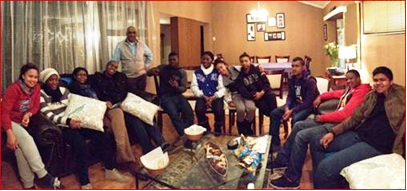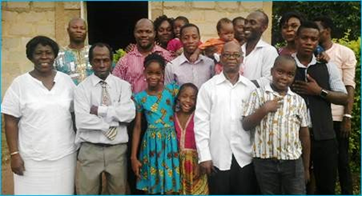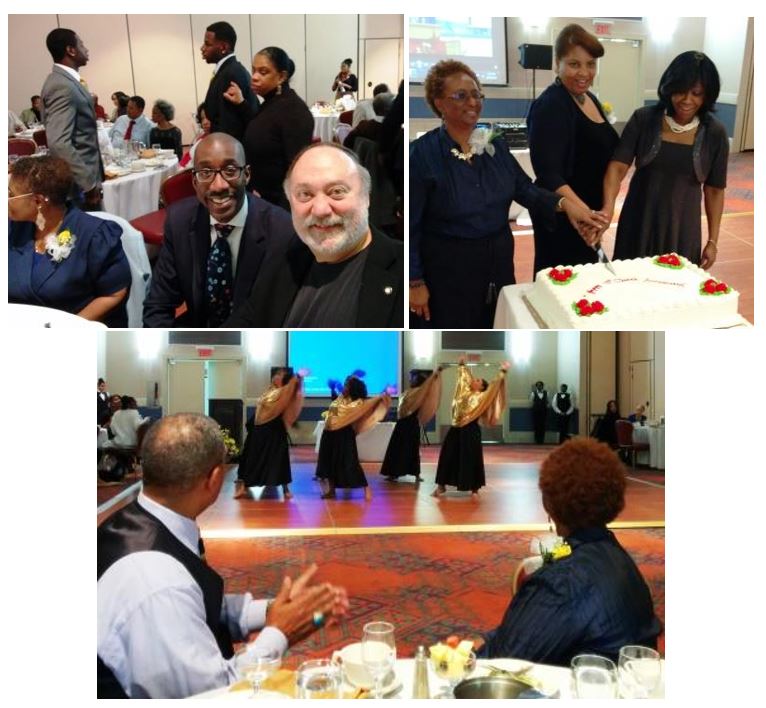GCI regional pastor Randy Bloom and his wife Debbie are celebrating a lot of “firsts.” Their firstborn child Lisa, who lives with her husband Chris Higgins in Paris, on December 13 delivered her first child, Amos Ryan Higgins (6½ pounds—see picture below). Now Randy and Debbie are celebrating their first grandchild! Randy and Debbie are in Paris visiting their new grandson. It will be a memorable Christmas and New Year! Congratulations to all.
Year: 2014
Richard Ridgell
Here from his wife Pam, is an update on Pastor Richard Ridgell’s battle with cancer. Click here for the earlier prayer request.

It has been a hard few months since I last updated you on Richard’s lung cancer ordeal. It has been an uphill battle for him. He has had to go on oxygen at home and is filing for long-term sick leave at his job. He will be cut to half salary but will continue his health and life insurance for six months. Richard is still taking medication for the cancer but will know more when he visits the doctor next week. I have been doing the sermons the last two weeks at church but he is hoping he can make it this week as he has a Christmas series ready to go. We will be glad when 2014 ends and we can start a new year. This one has been tough for us. But we know that God is the one in charge and we are trusting him for strength to get us through what he has planned for us. We thank everyone for their prayers and we continue to ask for them.
Cards may be sent to:
Johannsens’ 40th
Jesus: Merely a myth?
Dear Brothers and Sisters in Christ,
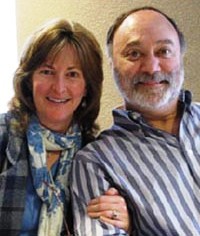 The Advent-Christmas season is a time of joy, hope and promise as we reflect on Jesus and the Incarnation. People all over the world are telling the story about his birth. The airwaves are filled with songs of the season. Churches are celebrating with pageants, cantatas and choirs. It’s the time of the year when you’d think the whole world has a chance to learn the truth about Jesus, the Messiah.
The Advent-Christmas season is a time of joy, hope and promise as we reflect on Jesus and the Incarnation. People all over the world are telling the story about his birth. The airwaves are filled with songs of the season. Churches are celebrating with pageants, cantatas and choirs. It’s the time of the year when you’d think the whole world has a chance to learn the truth about Jesus, the Messiah.
Sadly, many don’t get the full meaning of the season and simply celebrate Christmas because of the holiday spirit. They miss out on so much because either they don’t know Jesus or have fallen for the lie that Jesus is merely a myth—a contention that has been around since Christianity began.

This time of year it’s common for articles to declare that “Jesus is a myth,” typically noting that the Bible is unreliable as a source of history. But these claims overlook the fact that the Bible has been around far longer than many “credible” sources. Historians often cite as reliable the writings of historian Herodotus. Yet there are only eight known copies of his writings, with the earliest dated 900 A.D.—some 1,300 years after Herodotus’ time.
Contrast that with the “discounted” New Testament, which was written shortly following Jesus’ death and resurrection. The earliest New Testament manuscript (a fragment from the Gospel of John) is dated A.D. 125-130 A.D. There are more than 5,800 complete or fragmented copies of the New Testament in Greek, about 10,000 in Latin and 9,300 in other languages. Let me share with you three notable quotes that point to the authenticity of the New Testament accounts of Jesus’ life.
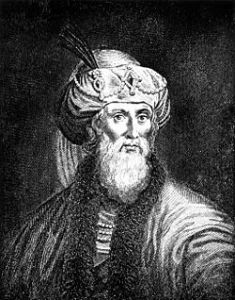
The first quote is from first century Jewish historian, Flavius Josephus:
Now there arose at this time a source of further trouble in one Jesus, a wise man who performed surprising works, a teacher of men who gladly welcomed strange things. He led away many Jews, and also many of the Gentiles. He was the so-called Christ. When Pilate, acting on information supplied by the chief men around us, condemned him to the cross, those who had attached themselves to him at first did not cease to cause trouble, and the tribe of Christians, which has taken this name from him is not extinct even today. (Antiquities, 18.3.3)
F.F. Bruce, who translated this quote, noted that, “The historicity of Christ is as axiomatic for an unbiased historian as the historicity of Julius Caesar.”

The second quote is from Roman historian Carius Cornelius Tacitus who also wrote in the first century. Referring to accusations that Nero burned Rome and then blamed Christians, he wrote this:
Nero procured others to be accused, and inflicted exquisite punishment upon those people, who were in abhorrence for their crimes, and were commonly known by the name of Christians. They had their denomination from Christus, who in the reign of Tiberius was put to death as a criminal by the procurator Pontius Pilate… At first they were only apprehended who confessed themselves of that sect; afterwards a vast multitude discovered by them, all of which were condemned, not so much for the crime of burning the city, as for their enmity to mankind. (Annals, 15, 44)

The third quote is from Gaius Suetonius Tranquillus, official historian of Rome during the reigns of Trajan and Hadrian. In a book written in A.D. 125 concerning the lives of the first twelve Caesars, Suetonius wrote this about Claudius (who reigned from A.D. 41 to 54):
He banished the Jews from Rome, who were continually making disturbances, Chrestus being their leader. (Life of Claudius 25.4, and note his spelling of Christ as “Chrestus”)
Suetonius’s statement points to the growth of Christianity in Rome prior to A.D. 54, only two decades after Jesus’ death. Reflecting on this and other evidence, British New Testament scholar I. Howard Marshall concluded: “It is not possible to explain the rise of the Christian church or the writing of the Gospels and the stream of tradition that lies behind them without accepting the fact that the Founder of Christianity actually existed.”
Though other scholars doubt the authenticity of the first two quotes and a few even claim them to be forgeries by Christians, the criterion for validating these references is solid. I enjoy a comment made by historian Michael Grant in his book, Jesus: An Historian’s Review of the Gospels: “If we apply to the New Testament, as we should, the same sort of criteria as we should apply to other ancient writings containing historical material, we can no more reject Jesus’ existence than we can reject the existence of a mass of pagan personages whose reality as historical figures is never questioned.”
Though skeptics are quick to dismiss what they don’t want to believe, there are exceptions. Noted skeptic and liberal theologian John Shelby Spong wrote in Jesus for the Non-Religious, that “Jesus was, first of all, a human being who actually lived at a particular time in a particular place. The man Jesus was not a myth, but a figure of history from whom enormous energy flowed—energy that still in our day cries out to be adequately explained.”
In his days as an atheist, C.S. Lewis believed that the New Testament accounts about Jesus were mere legends. But when he read them for himself and compared them with what he knew of actual ancient legends and myths, he saw clearly that these writings were nothing of the sort. They had the form and quality of recollections concerning the daily life of a real person. With that recognition, a barrier to faith fell away. From that point forward, Lewis had no problem believing in the historical reality of Jesus.
Many skeptics assert that Albert Einstein, as an atheist, did not believe in Jesus. Though Einstein did not believe in a “personal God,” he refused to combat those who did, because “Such a belief seems to me preferable to the lack of any transcendental outlook” (Einstein and Religion: Physics and Theology, by Max Jammer). Einstein, who grew up a Jew, admitted to being “enthralled by the luminous figure of the Nazarene.” When asked by an interviewer if he accepted the historical existence of Jesus, Einstein gave this reply: “Unquestionably. No one can read the Gospels without feeling the actual presence of Jesus. His personality pulsates in every word. No myth is filled with such life. How different, for instance, is the impression which we receive from an account of legendary heroes of antiquity like Theseus. Theseus and other heroes of his type lack the authentic vitality of Jesus” (“What Life Means to Einstein: An Interview,” by George Sylvester Viereck, The Saturday Evening Post, October 26, 1929).
I could go on, but as Roman Catholic scholar Raymond Brown has rightly noted, concentrating on the question of Jesus being a myth causes many to miss the real point of the Gospels. In The Birth of the Messiah, Brown mentions that he is often approached around Christmas by those wanting to write an article about the historicity of Jesus’ birth. “With little success I try to convince them that they could promote understanding of the birth stories by concentrating on the message of those stories instead of an issue that was very far from primary [for] the evangelists.”
When we keep our focus on sharing the story of Christmas, instead of on trying to convince people that Jesus was not a myth, we are giving living proof of Jesus’ reality. That living proof is the life he now lives in us and among us. The Bible’s focus and purpose is not to prove the historical validity of Jesus’ incarnation, but to share why he came and what his coming means to us. The Holy Spirit uses Scripture to put us in actual contact with the incarnate and risen Lord who draws us to himself that we might believe in him and worship the Father through him. Jesus came into the world as a demonstration of God’s love for each and every one of us (1 John 4:10). Here are a few other reasons why he came:
- To seek and save the lost (Luke 19:10).
- To save sinners and call them to repentance (1 Timothy 1:15, Mark 2:17).
- To make himself a ransom for humanity (Matthew 20:28).
- To bear witness to the truth (John 18:37).
- To do the will of the Father, which is to bring many children to glory (John 5:30, Hebrews 2:10).
- To be the light of the world, the way, the truth and the life (John 8:12; 14:6).
- To preach the good news about the kingdom of God (Luke 4:43).
- To fulfill the law (Matthew 5:17)
- Because the Father sent him: “For God so loved the world, that he gave his only Son, that whoever believes in him should not perish but have eternal life. For God did not send his Son into the world to condemn the world, but in order that the world might be saved through him. Whoever believes in him is not condemned, but whoever does not believe is condemned already, because he has not believed in the name of the only Son of God” (John 3:16-18).
This month we celebrate the truth of God entering our world in Jesus. It is good for us to remember that not everyone knows this truth, and we have been invited (commissioned) to share it with others. Jesus is more than a historical figure—he is the Son of God who came to reconcile all to the Father in the Holy Spirit. That is what makes this season one of joy, hope and promise.
Enjoying the season,
Joseph Tkach
Exploratory trip to U.S.
Rey Taniajura, GCI-Philippines missions director, recently led a group of Filipinos on a journey around the U.S. exploring opportunities to plant GCI churches focused on reaching Filipinos living in the U.S. In this update, Rey reports on the final leg of the journey.

Together with Joe and Gie Manzano, my wife June and I were guests of Bart Baril and his wife Teresa who pastor GCI’s congregation in Port Orchard, Washington. Bart had arranged for us to meet representatives of the Pacific Northwest Ilocandia Association (PNIA), a group of more than 100 Filipinos living in the area. We gathered at PNIA’s building (where the GCI congregation meets for worship).
Bart and Teresa’s congregation and PNIA have partnered in various outreach activities in the area. Also, one of PNIA’s members, Josie, had been trained as a missionary by GCI-Philippines and sent to the Northwest. She has been connecting with various churches in the Port Orchard-Bremerton area and has raised up a small group. Josie will be connecting some of those she is working with to Pastor Bart.
Bob Persky
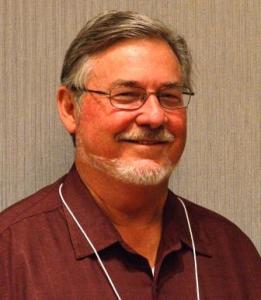 Please pray for Bob Persky, who recently retired as senior pastor of GCI’s congregation in Mesquite, Texas (Dallas metro area).
Please pray for Bob Persky, who recently retired as senior pastor of GCI’s congregation in Mesquite, Texas (Dallas metro area).
Bob will be having triple by-pass heart surgery with replacement of his aortic heart valve. The surgery is scheduled for December 17 at 7:30 a.m. at the Plaza Medical Center in Ft. Worth, Texas.
Please also pray for Bob’s wife Kay, who had open-heart surgery several weeks ago and continues to recover.
Cards may be sent to:
Bob and Kay Persky 129 Star Point Lane Weatherford, TX 76088-6409Susan McNutt
Susan McNutt is the director of Base Camp NW, one of Generations Ministries’ U.S. youth camps. Susan and her husband Lee Combs, Jr., were recently in a car accident. Susan apparently suffered a broken vertebra and sternum. Thankfully, there is no paralysis. Doctors have decided to put Susan in an upper body/neck cast. Though surgery is not now anticipated, blood clots are a major concern. Lee, who has bruising from the airbag and seat belt, was released from the hospital. Please keep Susan and Lee in your prayers.
Cards may be sent to:
Susan McNutt & Lee Combs, Jr.1827 NW Highland Dr.
Corvallis, OR 97330-2023
Life Club meetings
Geoff Sole provided the following updates on Life Club meetings held recently in various locations around the world.
Last spring, GCI’s London congregation held a trip for their young people to view a replica of Noah’s ark in the Netherlands (see picture below). It houses full-scale plastic animals, some small live animals and birds, two cinemas and a restaurant. As a result of the trip, the congregation’s Life Club held a meeting with a Noah’s ark theme.
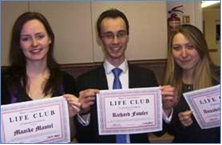 The Great Baddow, England, congregation held two Life Club meetings. At the first one, speeches were given on overcoming difficult circumstances, honoring parents, making a helpful difference in the lives of young people and perils and pitfalls of the first year of marriage. Graduation certificates were awarded to Maaike Mantel, Ricky Fowler and Annabelle Woolford (pictured at right). In the second meeting, speeches were given on the Church as “safety net,” health risks in eating genetically modified crops and cake-making.
The Great Baddow, England, congregation held two Life Club meetings. At the first one, speeches were given on overcoming difficult circumstances, honoring parents, making a helpful difference in the lives of young people and perils and pitfalls of the first year of marriage. Graduation certificates were awarded to Maaike Mantel, Ricky Fowler and Annabelle Woolford (pictured at right). In the second meeting, speeches were given on the Church as “safety net,” health risks in eating genetically modified crops and cake-making.
At a Life Club (pictured below) hosted by one of GCI’s Cape Town South Africa congregations, the winning speech was given on career perspectives. The club also helped organize a youth service in the host church, a walking trip up Lions Head mountain, and a social day visiting area beaches.
 GCI in South India held two Life Club meetings during their annual worship festival. At the first one, Patricia D’Costa (pictured at left), daughter of GCI pastor Joseph D’Costa, presented table topics. This was followed by four speeches, then a talk from pastor D’Costa on overcoming procrastination. Mission developer Rod Matthews then gave the overall evaluation, mentioning how club had helped him and encouraging others to participate.
GCI in South India held two Life Club meetings during their annual worship festival. At the first one, Patricia D’Costa (pictured at left), daughter of GCI pastor Joseph D’Costa, presented table topics. This was followed by four speeches, then a talk from pastor D’Costa on overcoming procrastination. Mission developer Rod Matthews then gave the overall evaluation, mentioning how club had helped him and encouraging others to participate.
 Colin Lauchlan (pictured at right), pastor of two GCI churches in Canada, runs a weekly Life Club in a Teen Challenge drug rehabilitation center in London, Ontario. Colin writes:
Colin Lauchlan (pictured at right), pastor of two GCI churches in Canada, runs a weekly Life Club in a Teen Challenge drug rehabilitation center in London, Ontario. Colin writes:
We usually average around 6-8 attendees on any one evening. I have a few people in the Club who really see the benefit and are very enthusiastic about it. I rely on them to recruit new members as they join the program. Because of the frequency of the meetings and the few attendees, some members have now given several speeches and it’s great to see their progress. We have just started a new format for our meetings so that members can have more time to prepare. We now have a regular Club one week and a lecture the following week. What I am doing on the lecture evening is playing a recording of a speech to the Club, then discussing with them techniques the speaker has employed in organizing and delivering his speech. Last week we discussed Abraham Lincoln’s Gettysburg address. It is fascinating to see how even the “great” speeches of our time employ the simple principles we teach in Life Club. Next time we will be looking at Martin Luther King’s “I Have a Dream” speech.
The Owerri, Nigeria congregation recently held a Life Club with 14 adults attending (see picture above). Chairperson Samuel Obih reminded members of the benefits of Club, including “taming the tongue” (from the book of James). Speeches were given on building a career and alternative ways of learning.
 In England, a Life Club meeting was held during the annual fall festival in Paignton. The chairperson was Gemma Brown and the topics leader was James Esom (pictured at left). Speeches addressed planting seeds spiritually, overcoming a poor childhood, how astronomers know if planets exist, and gratitude. Meeting director Roger Lippross said that “speech enhances life and we should not miss opportunities to speak in Club.” He also mentioned the importance of having vision and of persevering by keeping one’s goals clearly in mind.
In England, a Life Club meeting was held during the annual fall festival in Paignton. The chairperson was Gemma Brown and the topics leader was James Esom (pictured at left). Speeches addressed planting seeds spiritually, overcoming a poor childhood, how astronomers know if planets exist, and gratitude. Meeting director Roger Lippross said that “speech enhances life and we should not miss opportunities to speak in Club.” He also mentioned the importance of having vision and of persevering by keeping one’s goals clearly in mind.
Helping the poor
Following (with the author’s permission) is text excerpted from a post at The Walking Green blog. Given that many of our congregations seek to assist the poor, this post provides some helpful guidance. My wife Vicki met the author, Liz McEwen, through a local ministry that serves pastors’ wives. She and her husband are raising their children in an economically depressed neighborhood in Cincinnati. So she writes on this topic with in-depth, first-hand knowledge. The original post can be read online at https://ejmcewan.wordpress.com/2014/10/26/how-your-church-can-strengthen-the-hand-of-the-poor/.
– GCI pastor George Hart (Cincinnati, Ohio)
How Your Church Can “Strengthen The Hand” of the Poor
by Liz McEwen
If any of my Christian friends want to know what their churches can do to address the issue of poverty right now, I have a few suggestions.
Address poverty at its root. Poverty is not as simple as a lack of money or consistent employment. It is not always (or not only) a result of personal error. It is a complex cultural paradigm and often generations in the making. Solving the problem of poverty means tackling it at its root, in the systematic injustices and personal failures that perpetuate it. If you really want to pull someone out of a cycle of poverty, you have to get strategic and address a few key issues. Find an issue that you can (or your church can) personally address and commit to it. You may not be able to address it all, but you can certainly do something.
Educate. Without a proper education (at least through high school), the opportunities available to young men and women are limited. Something as simple as after-school tutoring could be a place to start, but perhaps you are capable of more. Other ideas: Start a community school or a co-op; become a teacher at a struggling school system; sit on the school board; become a high school academic counselor; create a college scholarship program.
Promote Strong Family Systems. There is a strong relationship between the stability of a family structure and poverty. In 2013, of the 11% of the American population living in poverty, 31% of them were households with a single mother. According to the statistics that same year, a married couple is much more likely to avoid poverty in the first place. Seeing as we are now entering an era in which almost half of the babies born are born into unmarried households, this might be an issue that the Church can address. Not by shaming unwed mothers. Not by ousting unmarried families. Not by coercing marriage. But by strengthening existing couples and encouraging healthy relationships, teaching basic conflict management skills, marital counseling, and by encouraging young women to abstain from sex (crazy, I know) to avoid becoming another “poor, unwed mother” statistic. For women (and men) currently parenting alone, churches can provide training in parenting skills and support in the way of daycare and counseling. For children who have already become victims of broken families, foster and short-term respite care, as well as adoption (open or closed, through public or private agencies) are great opportunities.
Improve the Quality of Life and Housing Opportunities. Have you considered the environmental and lifestyle issues that make it difficult for people to move out of a cycle of poverty? The availability of healthy food, access to public transportation options, clean, safe, and well-maintained neighborhoods—they all matter. What if your church started a housing ministry that rented or sold decent homes to low-income families without the mess of government subsidies? Or started a community housing co-op that enabled lower-income members to build equity in shared property? What if you started a community garden that provided fresh produce to local families in need or organized a block watch to promote community-led policing? You can plant trees for increased safety and air quality; you could provide free medical care or health education.
Teach Job Skills and Provide Employment. What would you do if you wanted to find a job that would provide for your family, but had a minimum education, few employable skills, or possibly even a felony on your record that (in an employer’s eyes) disqualified you from hundreds of available jobs? You or your church can help teach important skills that help secure employment for the otherwise unemployable: computer and technical skills; handyman, carpentry, or maintenance skills; cooking or cleaning. You could also take it one step further and start a business that employs those who have a difficult time finding employment or hire an under-employed person in your community to do odd jobs (at your church or your home) for extra cash to help make ends meet.
Give Financial Guidance. There are financial skills that some wealthier people take for granted—things they learned from their parents or peers about how to manage their money, how to save money and stay out of debt, or how to make smart investments. Don’t take for granted that other people know these things. Things as simple as how to open a bank account, balance a check book, or pay a bill online might be a mystery to some folks. Without basic financial knowledge and wisdom about managing wealth, a sudden increase in income that comes with new employment can destroy a family’s financial future. Your church can provide something as simple as free financial counseling or as complex as interest-free personal or business loans.
Fight Institutional Injustice. Sure, plenty of people living in poverty are victims of their own bad decisions. But, many are not. Regardless of how they got into the mess they are in, there are mountains upon mountains of institutional injustices that can make it feel impossible for them to climb out. Christians should be in the business of pleading the case of victims. Either find a way to advocate for those who are in danger of being further victimized and left with no resources and no support, or use your skills and influence to work within the system to bring justice on an institutional level. The judicial system, banking, legislation, urban planning and community development, immigration—take your pick. Globally, nationally, or locally.
Soothe the symptoms of poverty. Emergency assistance will not stop the cycles of poverty, but it can soothe the symptoms. Christians should not be afraid to meet a need where an obvious need exists. Educate yourself about what resources exist in your community, but also consider how you can step in with a more personal touch. A lot of us are afraid of being taken advantage of or being made fools, but churches should be places of hospitality and generosity. You can be wise about the help you offer while still being generous and merciful. Keep healthy boundaries, but keep your doors open—physically, spiritually and emotionally. Pray that God refines your discernment to know where the real needs are.
You may have noticed that I didn’t list “Provide Spiritual Guidance” on the list above. The reason is that I take for granted that Christians understand that they have a responsibility to preach the gospel to all people whether poor or wealthy. Spiritual poverty knows no economic boundaries, so providing spiritual guidance should be a given, at all times, to all people. “Strengthening the hand of the poor,” however, is a particular command given to the church in relationship to a particular group of people and can be discussed with spiritual realities presupposed.
Magnificent joy!
Dear Brothers and Sisters in Christ,
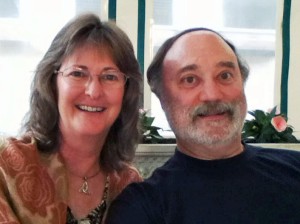 Recently, three couples who are our dear friends shared that they are expecting grandchildren. For two couples, it’s their first grandchild and they gave me a delightful rundown of their plans to be present at the birth. For the third couple, it’s their second grandchild and they too plan to be present for the wonderful event.
Recently, three couples who are our dear friends shared that they are expecting grandchildren. For two couples, it’s their first grandchild and they gave me a delightful rundown of their plans to be present at the birth. For the third couple, it’s their second grandchild and they too plan to be present for the wonderful event.
Tammy and I still remember the glorious emotions we experienced awaiting the arrival of both of our children. We still talk about it as if it were yesterday. I imagine most of you share similar memories and some of you are anticipating the wondrous time of new life in the weeks or months ahead. So it’s fairly easy for most of us to identify with the joy felt by two pregnant women in Luke’s account known as The Visitation.
At that time Mary got ready and hurried to a town in the hill country of Judea, where she entered Zechariah’s home and greeted Elizabeth. When Elizabeth heard Mary’s greeting, the baby leaped in her womb, and Elizabeth was filled with the Holy Spirit. In a loud voice she exclaimed: “Blessed are you among women, and blessed is the child you will bear!… As soon as the sound of your greeting reached my ears, the baby in my womb leaped for joy (Luke 1:39-42, 44).
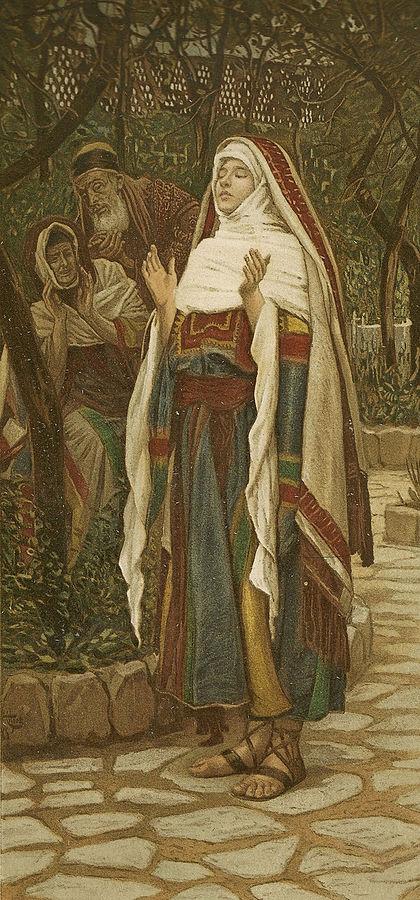
In response, Mary offered a song known as The Magnificat.
“My soul magnifies the Lord, and my spirit rejoices in God my Savior, for he has regarded the low estate of his handmaiden. For behold, henceforth all generations will call me blessed; for he who is mighty has done great things for me, and holy is his name. And his mercy is on those who fear him from generation to generation. He has shown strength with his arm, he has scattered the proud in the imagination of their hearts, he has put down the mighty from their thrones, and exalted those of low degree; he has filled the hungry with good things, and the rich he has sent empty away. He has helped his servant Israel, in remembrance of his mercy, as he spoke to our fathers, to Abraham and to his posterity forever” (Luke 1:46-55, RSV).
The phrase “my soul magnifies the Lord” can mean to praise, glorify, celebrate, adore, enlarge, exalt or extol. The words convey an experience of being enlarged, lifted up and out of one’s self by power from another realm. This is a quality of joy and hope that transcends human emotion—it comes only from God.
Mary’s song, which weaves together the language of several of the Psalms, is patterned closely on the song of Hannah, who could not bear children until the Lord visited her (1 Samuel 2:1–10). While Mary’s song is focused on humility and calmness, Hannah’s song focuses on her sense of indignation, followed by personal triumph. An unusual feature of both songs is that God is portrayed in terms of what he has done as well as what he will yet do. This is a literary technique where the past tense is used to express hope for the future. Both songs remind us that what God has done in the past is what God will do in the future. As we continue to celebrate Advent, we celebrate this fact—noting God’s involvement in our past and relying on his involvement in our future. We rejoice in knowing that all God’s acts are the fruit of his consistent character—his faithfulness demonstrated in Jesus Christ.
Another noteworthy feature in Mary’s and Hannah’s songs is that God’s justice and mercy are presented in terms of the reversal of fortunes for the proud and the humble, the mighty and the lowly, the rich and the poor. The God of our past and future will make everything right, straighten everything that is crooked and heal all that is broken. We read of this in Isaiah 40:1-5, a passage often sung during Advent in performances of Handel’s sacred oratorio, Messiah.
The biblical accounts of Hannah and Mary (with Elizabeth) are chock-full of symbolism and prototypes from the past. Both Hannah and Elizabeth were barren until, in their later years, God intervened miraculously as he had for Sarah, Abraham’s wife. In the Old Testament, barrenness was much worse than an inability to bear children—it was a symbol of the end of human potential, the choking off of life. It pointed to the impotence of the human race in the face of sin and death. It’s no wonder that God would use a barren woman, Elizabeth, to point to his Son Jesus, who announced and accomplished the astounding reversal that Isaiah and other prophets proclaimed.
At Mary’s greeting, Elizabeth, who was pregnant with John the Baptist, said “the baby in my womb leaped for joy.” Both Elizabeth and Mary experienced great joy in receiving and proclaiming God’s sure promise concerning the future. They knew that God’s promises always come with the power to see them fulfilled. The overlapping pregnancies of these women were beautiful signs that what was promised was about to happen. In God’s economy, it already had! Mary’s song—The Magnificat—celebrates the divine events as though they already had occurred. She knew that God is as good as his Word!
Mary and Elizabeth symbolically represent the poor and oppressed, those of “low estate,” who can be filled with joy knowing their hope is in God who is faithful to fulfill what he has promised. The two miraculous pregnancies are living examples of what Jesus later proclaimed: “With man this is impossible, but with God all things are possible” (Matthew 19:26). In his almighty love, God entered this world in human flesh. All who positively, willingly respond to that love by embracing their new lives in Christ, will experience magnificent joy for all eternity.
In joy,
Joseph Tkach
PS: It was a treat for me to join Pastor Frank and Leslie Howard in Newark, New Jersey to celebrate the 15th anniversary of the 24/7 Community Church. This is the first church plant after our doctrinal transformation. They began with 14 members and now have 125. Here are four pictures of the event, bearing in mind that I make no claim to being a photographer.





